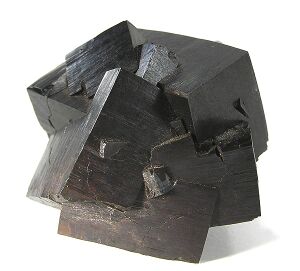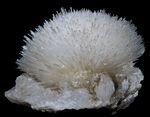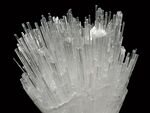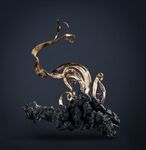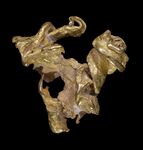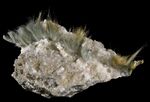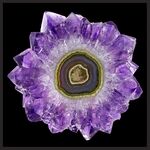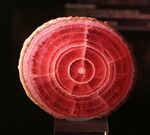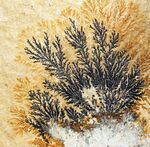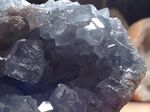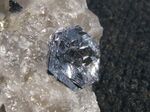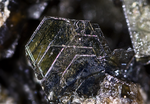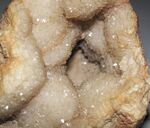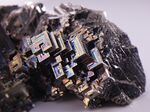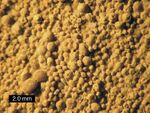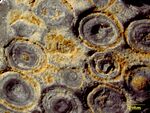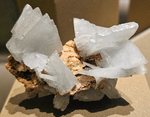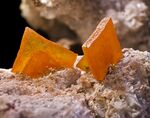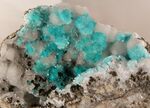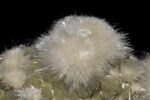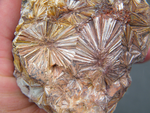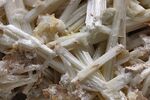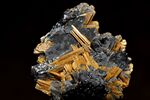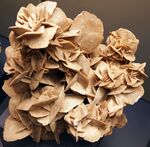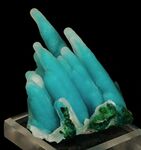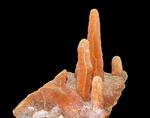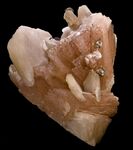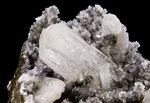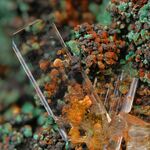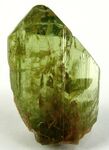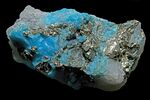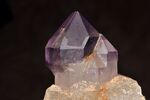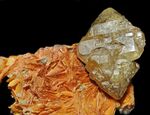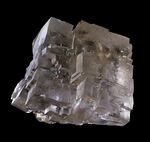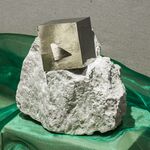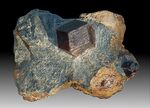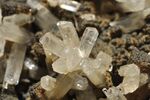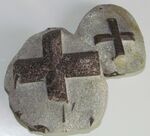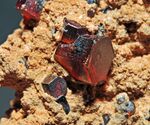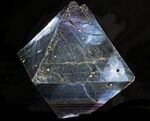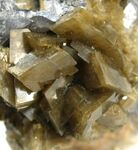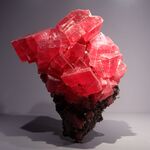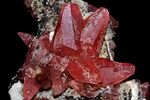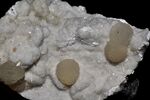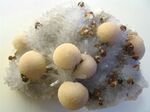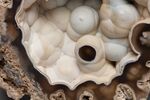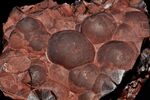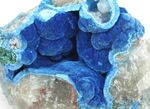هيئة البلورة
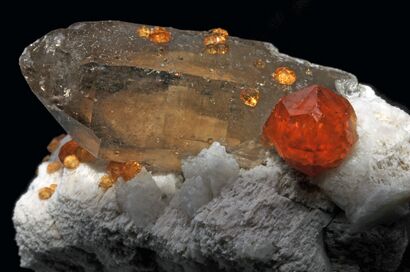
In mineralogy, crystal habit is the characteristic external shape of an individual crystal or aggregate of crystals. The habit of a crystal is dependent on its crystallographic form and growth conditions, which generally creates irregularities due to limited space in the crystallizing medium (commonly in rocks).[1][2]
. . . . . . . . . . . . . . . . . . . . . . . . . . . . . . . . . . . . . . . . . . . . . . . . . . . . . . . . . . . . . . . . . . . . . . . . . . . . . . . . . . . . . . . . . . . . . . . . . . . . . . . . . . . . . . . . . . . . . . . . . . . . . . . . . . . . . . . . . . . . . . . . . . . . . . . . . . . . . . . . . . . . . . . .
أشكال البلورات
Recognizing the habit can aid in mineral identification and description, as the crystal habit is an external representation of the internal ordered atomic arrangement.[1] Most natural crystals, however, do not display ideal habits and are commonly malformed. Hence, it is also important to describe the quality of the shape of a mineral specimen:
- Euhedral: a crystal that is completely bounded by its characteristic faces, well-formed. Synonymous terms: idiomorphic, automorphic;
- Subhedral: a crystal partially bounded by its characteristic faces and partially by irregular surfaces. Synonymous terms: hypidiomorphic, hypautomorphic;
- Anhedral: a crystal that lacks any of its characteristic faces, completely malformed. Synonymous terms: allotriomorphic, xenomorphic.
Altering factors
Factors influencing habit include: a combination of two or more crystal forms; trace impurities present during growth; crystal twinning and growth conditions (i.e., heat, pressure, space); and specific growth tendencies such as growth striations. Minerals belonging to the same crystal system do not necessarily exhibit the same habit. Some habits of a mineral are unique to its variety and locality: For example, while most sapphires form elongate barrel-shaped crystals, those found in Montana form stout tabular crystals. Ordinarily, the latter habit is seen only in ruby. Sapphire and ruby are both varieties of the same mineral: corundum.
Some minerals may replace other existing minerals while preserving the original's habit, i.e. pseudomorphous replacement. A classic example is tiger's eye quartz, crocidolite asbestos replaced by silica. While quartz typically forms prismatic (elongate, prism-like) crystals, in tiger's eye the original fibrous habit of crocidolite is preserved.
List of crystal habits
[3][مطلوب مصدر أفضل][4][مطلوب مصدر أفضل][5][مطلوب مصدر أفضل][6]
Aggregate habits
| Habit | Image | Description | Common example(s) | ||
|---|---|---|---|---|---|
| Acicular | Needle-like, slender, and end-tapered prisms growing in a radial/globular fashion. | natrolite, scolecite, yuanfuliite | |||
| Arborescent | Tree-like crystals growing similar to branches. | copper, gold, silver | |||
| Capillary/Filiform | Hair-like or thread-like, extremely fine | byssolite, millerite | |||
| Colloform/Nodular/Tuberose | Rounded, finely banded deposits with irregular concentric protuberances | agate, baryte, sphalerite | |||
| Concentric | Circular ring aggregates around a center. This habit is found in cross-sections from reniform/mamillary habits, and also from elongated stalactites of amethyst (quartz), malachites, rhodocrosite, and others | agate, quartz, malachite, rhodocrosite | |||
| Dendritic | Root-like, branching in one or more direction from central point | copper, gold, romanechite, magnesite, silver | |||
| Druse/Encrustation | Aggregate of crystals coating a surface or cavity, usually found in geodes and some fossils | azurite, celestine, calcite, uvarovite, malachite, quartz | |||
| Fibrous/Asbestiform | Extremely slender prisms forming muscle-like fibers | actinolite, asbestos, baryte, kyanite, gypsum, nitratine, stilbite, serpentine group | |||
| Foliated/Micaceous/Lamellar | Layered crystal planes, parting into thin sheets | biotite, hematite, muscovite, lepidolite, molybdenite | |||
| Granular | Aggregates of diminute anhedral crystals in matrix or other surface | andradite, bornite, scheelite, quartz, uvarovite | |||
| Hopper | Outer portions of cubes grow faster than inner portions, creating a concavity similar to that of a hopper | bismuth (artificial), halite, galena | |||
| Oolithic | Small cirumferences or grains (commonly flattened) that resemble eggs | aragonite, calcite | |||
| Pisolitic | Rounded concentric nodules often found in sedimentary rocks. Much larger than oolithic | aragonite, bauxite, calcite, pisolite | |||
| Platy/Tabular/Blocky | Flat, tablet-shaped, prominent pinnacoid | baryte, feldspar, topaz, vanadinite, wulfenite | |||
| Plumose | Fine, feather-like scales | aurichalcite, okenite, mottramite | |||
| Radial/Radiating/Divergent | Radiating outward from a central point without producing a star (crystals are generally separated and have different lengths). | aenigmatite, atacamite, epidote, pyrophyllite, stibnite | |||
| Reticulated | Crystals forming triangular net-like intergrowths. | cerussite, rutile | |||
| Rosette/Lenticular | Platy, radiating rose-like aggregate (also lens shaped crystals) | gypsum, baryte, calcite | |||
| Stalactitic | Forming as stalactites or stalagmites; cylindrical or cone-shaped. Their cross-sections often reveal a "concentric" pattern | calcite, chalcedony, chrysocolla, goethite, malachite, romanechite | |||
| Stellate | Star-like, radial fibers found inside spherical habits, such as mamillary or reniform. | hematite, pectolite, shattuckite, wavellite |
. . . . . . . . . . . . . . . . . . . . . . . . . . . . . . . . . . . . . . . . . . . . . . . . . . . . . . . . . . . . . . . . . . . . . . . . . . . . . . . . . . . . . . . . . . . . . . . . . . . . . . . . . . . . . . . . . . . . . . . . . . . . . . . . . . . . . . . . . . . . . . . . . . . . . . . . . . . . . . . . . . . . . . . .
Asymmetrical/Irregular habits
| Habit | Image | Description | Common example(s) | ||
|---|---|---|---|---|---|
| Amygdaloidal | Like embedded almonds | heulandite, stilbite, zircon | |||
| Hemimorphic | Doubly terminated crystal with two differently shaped ends | elbaite, hemimorphite, olivine | |||
| Massive/Compact | Shapeless, no distinctive external crystal shape | limonite, turquoise, cinnabar, quartz, realgar, lazurite | |||
| Sceptered | Crystal growth stops and continues at the top of the crystal, but not at the bottom. Exceptional aggregates of this habit (such as quartz) are often referred as "Elestial". | baryte, calcite, marcasite, quartz |
Symmetrical habits
| Habit | Image | Description | Common example(s) | ||
|---|---|---|---|---|---|
| Cubic | Cube-shaped | fluorite, pyrite, galena, halite | |||
| Dodecahedral | Dodecahedron-shaped, 12-sided. Central facet can vary. | garnet, pyrite | |||
| Enantiomorphic | Mirror-image habit (i.e. crystal twinning) and optical characteristics; right- and left-handed crystals | aragonite, gypsum, quartz, plagioclase, staurolite | |||
| Hexagonal | Hexagonal prism (six-sided) | beryl, galena, quartz, hanksite, vanadinite | |||
| Icositetrahedral | Icositetrahedron-shaped, 24-faced | analcime, spessartine | |||
| Octahedral | Octahedron-shaped, square bipyramid (eight-sided) | diamond, fluorine, fluorite, magnetite, pyrite | |||
| Prismatic | Elongate, prism-like: may or not present well-developed crystal faces parallel to the vertical axis | beryl, tourmaline, vanadinite | |||
| Rhombohedral | Rhombohedron-shaped (six-faced rhombi) | calcite, magnesite, rhodochrosite, siderite | |||
| Scalenohedral | Scalenohedron-shaped, pointy ends | calcite, rhodochrosite, titanite | |||
| Tetrahedral | Tetrahedron-shaped, triangular pyramid (four-sided) | chalcopyrite, tetrahedrite, sphalerite, magnetite |
. . . . . . . . . . . . . . . . . . . . . . . . . . . . . . . . . . . . . . . . . . . . . . . . . . . . . . . . . . . . . . . . . . . . . . . . . . . . . . . . . . . . . . . . . . . . . . . . . . . . . . . . . . . . . . . . . . . . . . . . . . . . . . . . . . . . . . . . . . . . . . . . . . . . . . . . . . . . . . . . . . . . . . . .
Rounded/Spherical habits
| Habit | Image | Description | Common example(s) | ||
|---|---|---|---|---|---|
| Botryoidal | Grape-like, large and small hemispherical masses, nearly differentiated/separated from each other | calcite, chalcedony, halite, plumbogummite, smithsonite | |||
| Globular | Isolated hemispheres or spheres | calcite, fluorite, gyrolite | |||
| Mammillary | Breast-like: surface formed by intersecting partial spherical shapes, larger version of botryoidal and/or reniform, also concentric layered aggregates. | chalcedony, hematite, malachite | |||
| Reniform | Irregular kidney-shaped spherical masses | cassiterite, chalcedony, chrysocolla, hematite, hemimorphite fluorite, goethite, greenockite, malachite, rhodochrosite, smithsonite, mottramite, wavellite |
See also
References
- ^ أ ب Klein, Cornelis, 2007, Minerals and Rocks: Exercises in Crystal and Mineral Chemistry, Crystallography, X-ray Powder Diffraction, Mineral and Rock Identification, and Ore Mineralogy, Wiley, third edition, ISBN 978-0471772774
- ^ Wenk, Hans-Rudolph and Andrei Bulakh, 2004, Minerals: Their Constitution and Origin, Cambridge, first edition, ISBN 978-0521529587
- ^ "What are descriptive crystal habits". Archived from the original on 2017-07-07. Retrieved 2009-04-06.
- ^ Crystal Habit Archived 2009-04-12 at the Wayback Machine
- ^ "Habit". Archived from the original on 2017-12-01. Retrieved 2009-04-06.
- ^ Hanaor, D.A.H; Xu, W; Ferry, M; Sorrell, CC (2012). "Abnormal grain growth of rutile TiO2 induced by ZrSiO". Journal of Crystal Growth. 359: 83–91. arXiv:1303.2761. Bibcode:2012JCrGr.359...83H. doi:10.1016/j.jcrysgro.2012.08.015. S2CID 94096447.
Bibliography
- Kostov, Ivan; Kostov, Ruslan I. (1999). Crystal Habits of Minerals. Sofia: Academic Publishing House "Prof. Marin Drinov". ISBN 9789546420602. OCLC 488807766.
